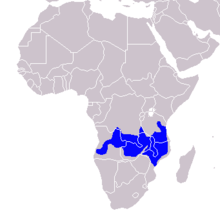Pale Beak Toko
| Pale Beak Toko | ||||||||||
|---|---|---|---|---|---|---|---|---|---|---|

Tockus pallidirostris subsp. pallidirostris , male |
||||||||||
| Systematics | ||||||||||
|
||||||||||
| Scientific name | ||||||||||
| Tockus pallidirostris | ||||||||||
| ( Hartlaub & Finsch , 1870) |
The Blassschnabeltoko ( Tockus pallidirostris ) is a bird art that the hornbills belongs (Bucerotidae) and in sub-Saharan Africa occur. Like all hornbills of the genus Tokos, the Pale Beaked Toko is also a cave breeder. The female walls herself up in the nest cavity and is fed by the male during the breeding season. Despite the comparatively large distribution area, only two subspecies are distinguished for this species.
The population of the Pale Beaked Toko was classified in the IUCN Red List of Threatened Species in 2016 as “ Least Concern (LC) ” = “not endangered”.
features
The Pale Beaked Toko reaches a body length of up to 50 centimeters and weighs between 200 and 325 grams. The gender dimorphism is not very pronounced.
Features of the nominate form
Males have a dark gray throat and nape. A wide white stripe runs from above the eye to the nape of the neck. The back is black, the tail feathers soot-brown with white tips, which are only missing in the middle pair of control feathers . The underside of the body is whitish. The wings of the hand and arm as well as the feathers of the wing covers are soot-brown with narrow isabel-colored hems. The beak is creamy yellow with a few gray spots and a gray tip. The horn ends abruptly in the front third of the beak. The eyes are red to red-brown, the legs and feet are soot-brown.
The females correspond to the males in the body plumage, but have a smaller and shorter horn. The eyes are brown. In young birds, the beak is even smaller.
Characteristics of the subspecies Tockus pallidirostris neumanni
The subspecies Tockus pallidirostris neumanni ( Reichenow , 1894) is somewhat smaller than the nominate form Tockus pallidirostris pallidirostris . The head and neck are paler than in the nominate form, the beak has a reddish tip that extends to the horn and the edges of the beak. The iris is brown in both sexes.
voice
The calls of the Pale Beaked Toko are elongated whistles that are similar to the calls of the Gray Tokos, but are somewhat deeper and softer than those of this type of Toko.
Possible confusion
The distribution area of the pale-billed tooko overlaps with that of the gray tooko in some regions . This one has a similar body plumage, a similar flight pattern and a similar voice. The most striking distinguishing feature between the two species is the beak, which is black and white in the male and chestnut brown and cream-colored in the female. All other types of toko have a significantly darker body plumage.
Distribution area and habitat
The nominate form occurs in Angola and eastern Zambia, but is absent in the Luangwa Valley and has only been observed once on the west bank of Lake Tanganyika . The subspecies T. p. neumanni is common in Zambia, the east of the Luangwa Valley, in Malawi, Mozambique and in the south of Tanzania. In the south of Kenya this subspecies can also be observed occasionally.
The habitat is dense stands of Brachystegia in extensive forest savannas below 1400 meters above sea level. The gray togo, with whose distribution areas the Pale Beaked Toko partially overlaps, inhabits denser forest stands.
Way of life
The Pale Beaked Toko finds its food predominantly in the treetops, but occasionally comes to the ground to look for food. It can usually be seen in pairs or in small family groups of five to eight individuals.
The food spectrum and the breeding biology of the pale-billed coconut have not yet been conclusively investigated. The Pale Beaked Toko is presumably omnivorous with a food spectrum that includes not only animal food but also fruits and seeds.
Like all tokos, the Pale Beaked Toko is also a cave breeder. The nest hole is in trees. The female sitting in the nesting cavity condenses the cave entrance to a narrow, vertical slit. The males carry food and feed both the female and the later hatching nestlings. While she sits in the nest hole for several weeks, the female goes through the moult.
Trivia
With the subspecies Tockus pallidirostris neumanni , the first describer Reichenow honored the German ornithologist and Africa traveler Oscar Neumann , who described numerous bird species on this continent on two long journeys to Africa.
literature
- W. Grummt , H. Strehlow (Ed.): Zoo animal keeping birds. Verlag Harri Deutsch, Frankfurt am Main 2009, ISBN 978-3-8171-1636-2 .
- Alan Kemp: The Hornbills - Bucerotiformes . Oxford University Press, Oxford 1995, ISBN 0-19-857729-X .
Single receipts
- ↑ Lophoceros pallidirostris in the endangered Red List species the IUCN 2016 Posted by: BirdLife International, 2016. Retrieved on 3 October 2017th
- ↑ Kemp: The Hornbills - Bucerotiformes . P. 122.
- ↑ Kemp: The Hornbills - Bucerotiformes . P. 121.
- ↑ Calls of the Pale Beaked Toko on Xeno-Canto , accessed on October 2, 2016
- ↑ Bo Beolens, Michael Watkins: Whose Bird? Men and Women Commemorated in the Common Names of Birds . Christopher Helm, London 2003, p. 205.
Web links
- Lophoceros pallidirostris inthe IUCN Red List of Threatened Species 2013.2. Listed by: BirdLife International, 2012. Retrieved October 1, 2016.
- Calls of the Pale Beaked Toko on Xeno-Canto
